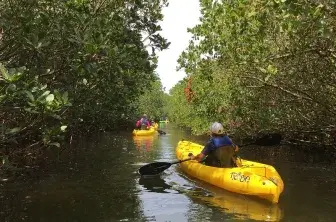Case study
Living Breakwaters: Using green infrastructure to build resilience

In October 2012, Hurricane Sandy devastated many coastal communities across the Northeast, including throughout Staten Island, New York. The storm and resulting flooding caused injuries and fatalities and destroyed many homes. These tragedies emphasized the extent to which decades of pollution, oyster overharvesting, and dredging had destroyed natural barriers that previously buffered much of the greater New York-New Jersey Harbor from storm surge and erosion. In collaboration with New York State and others, the landscape architecture firm SCAPE, developed a plan for a 1.5-mile necklace of “living breakwaters” off the South Shore of Staten Island to help reduce risk in the neighborhood of Tottenville, which was hit particularly hard by Sandy.i
Now under construction, the breakwaters are built of stone and biologically-enhanced concrete units configured into rocky crests that reduce damaging waves and help reverse coastal erosion. A number of breakwaters also feature structural modifications called “reef ridges” and “reef streets,” which introduce a mosaic of intertidal habitat space for fish, oysters, and other marine species. After construction is complete in 2024, the Billion Oyster Project, a New York-based nonprofit, will assist with oyster restoration through methods including seeding young oysters on the breakwaters and installing oyster, clam, and scallop shells recycled from New York restaurants to encourage reef growth. As the reef grows over time, it will boost the breakwaters’ ability to reduce waves, enhance water quality, and foster marine biodiversity.
The Living Breakwaters project also aims to build social cohesion onshore by engaging with and educating the local community. SCAPE and the Billion Oyster Project collaborated to develop an open-access Living Breakwaters Curriculum, which has been taught in local schools and is available online. This curriculum provides teachers with lesson plans that engage students on topics such as resilience, risk reduction, and local ecosystems, using the project as a case study for these themes. The curriculum also addresses that though the breakwaters reduce risk, climate change still presents continued threats to the community.
This public-private partnership demonstrates the potential for large-scale ecosystem restoration in severely degraded environments and can serve as a model for similar projects at a national and global scale. When complete, Living Breakwaters will have created marine ecosystems, reduced risk to the island’s vulnerable shoreline, and reached thousands of New Yorkers through outreach and education.



